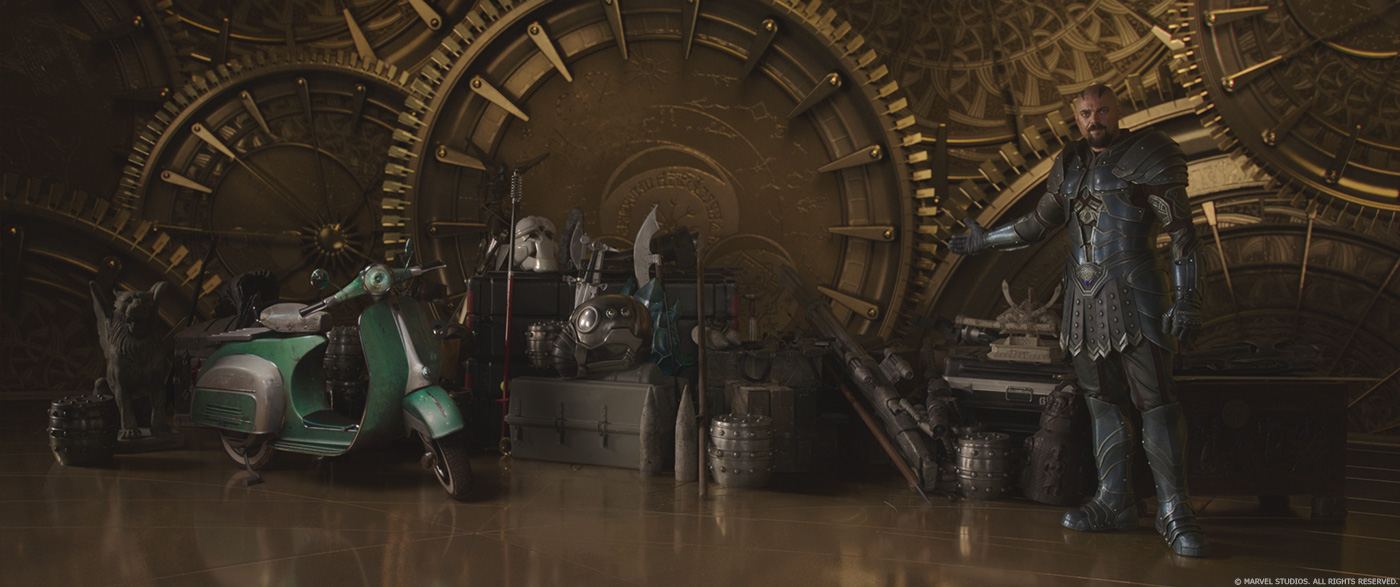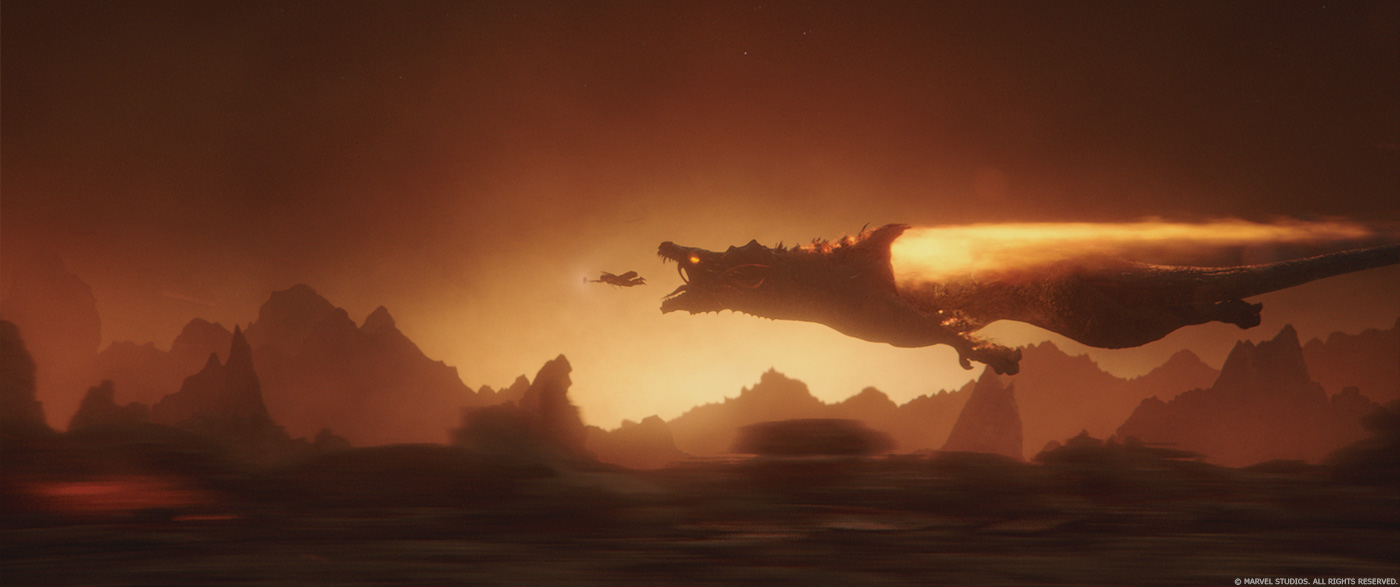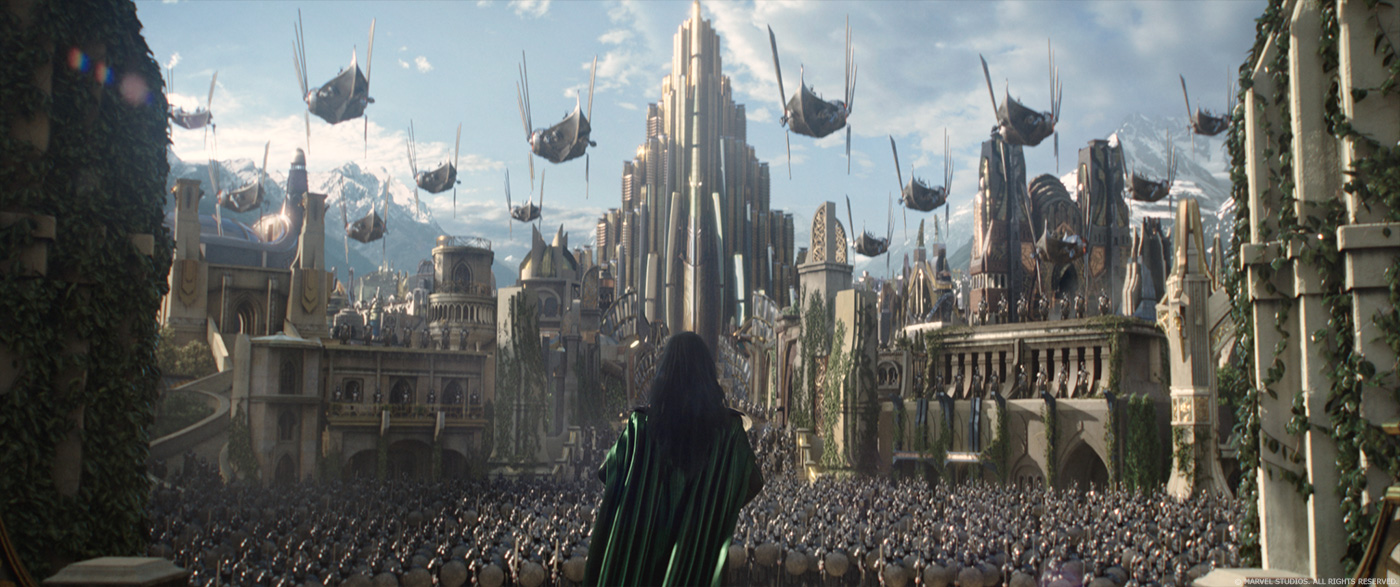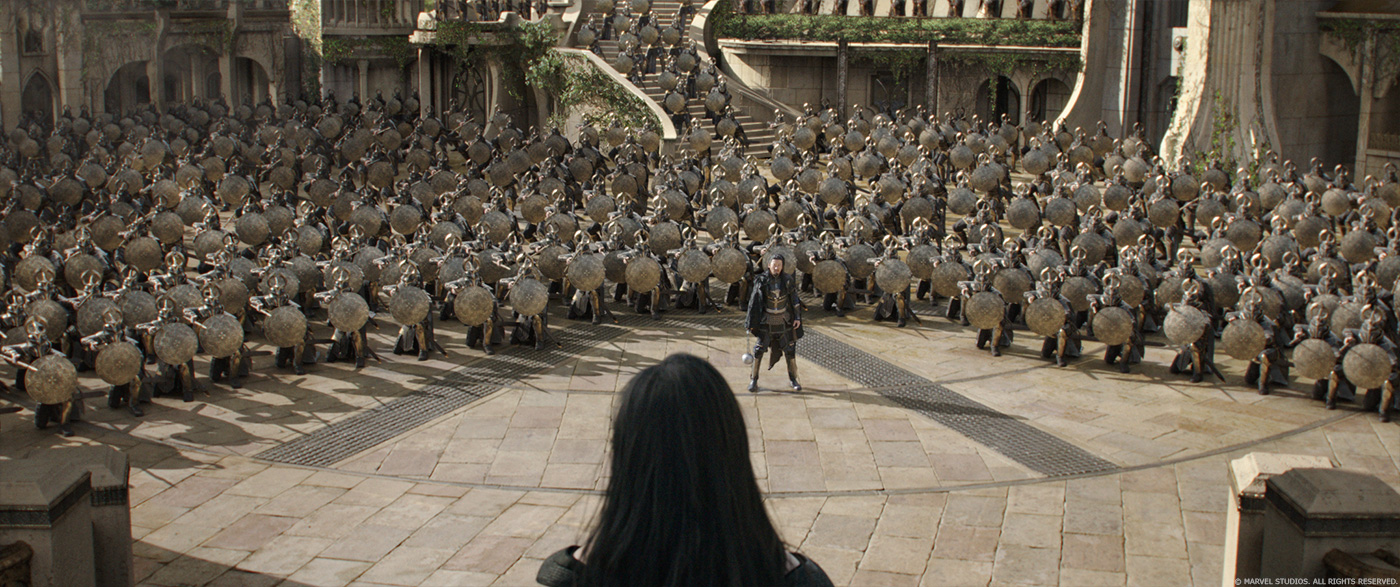Andrew Hellen has more than 20 years of experience in the visual effects. He worked at Fuel VFX and Iloura before joining Method Studios. He took care of the effects of films such as IRON MAN 2, GODS OF EGYPT, GHOSTBUSTERS and FANTASTIC BEASTS AND WHERE TO FIND THEM.
What was the approaches and expectations of Director Taika Waititi and VFX Supervisor Jake Morrison about the visual effects?
In broad terms, production wanted the approach to be based in reality, nothing too “magical.” We approached most FX tasks from a minimalist angle rather than over producing it; for example, Hela conjures weapons through gestures, not magic.
Obviously there have been two prior THOR films and Marvel have a fairly well established universe they have created, so we’re adding to that universe, but not hemmed in by it. The Marvel Universe has been evolving as it expands, so we were able to explore within those fairly broad boundaries.
The scenes we were a part of were diverse: two big fight scenes, one involving hundreds of characters in a huge fiery cavern, and the other thousands out in an Asgard plaza. We also handled the theater play, where we are on top of a building in downtown Asgard. The opening scene of Surtur was partially about establishing Thor at the top of his game and to give Mjolnir a strong moment before it gets destroyed and also to establish Surtur, his Skull and what Ragnorak is. The Elite Guard fight with Hela was partially about showing how indestructible she is and to establish how she conjures weapons of all types. The Theater scene was to establish Loki’s return in a comical way. So there were variations in the approaches taken to support the work involved as the expectations varied according to the purpose of each scene.
What are the sequences made at Method Studios?
Most of our work is in the first act in Surtur’s Lair, then on the surface of Musplehielm (Surtur’s world). We also did all of the interiors of the observatory, on top of an Asgard building with Loki pretending to be Odin watching the theater play about himself, Heimdall leading the Asgard citizens to the mountain stronghold, the interiors of the Mountain Stronghold, the Elite Guard (Eguard) fight with Hela, Hela and Skurge at the Mountain Stronghold, and on the steps in Asgard with Fenris and the captured Asgard citizens, though Framestore created Fenris so it was a shared scene. We also did a few other bits and pieces.
How did you organize the work at Method Studios?
We had around ten environments to build and a similar number of characters to create plus variations of some of those. Hela was her own unique technical challenge due to having actress Cate Blanchett’s face as live action and the rest of her being CG. Then there is the animation for all of these scenes, some involving thousands of characters, FX, explosions, cloth and hair sims, pretty much the full gamut of VFX.
We try to organize the work in the same way on most large scale projects. It usually starts with the studio turning over “keystone” shots. These are usually wide establishing shots for environments, a shot that shows a character clearly, or any big FX shot that needs lots of development time, like the shot of Hela destroying the stronghold doors. These early development shots are useful for several reasons: they flesh out what has until this point only been concept or a blue screen of a key actor, feed editorial with a guide as to what the film might look like when it’s all colored in and define the pipeline needed to mass produce the shots later down the line when full scenes have been turned over. Keystone shots are also often used for teaser trailers to help market the film. The idea is to build all of these characters, environments and heavy FX dev work in the early stages of the process with a relatively contained team, preparing yourself for when the edit is locked or turnover happens.
For big animation scenes, production provides both previz and postviz. We generally pick a handful of shots that we all feel fairly certain will remain in the cut, and start to develop those shots while we wait for the cut to lock down.
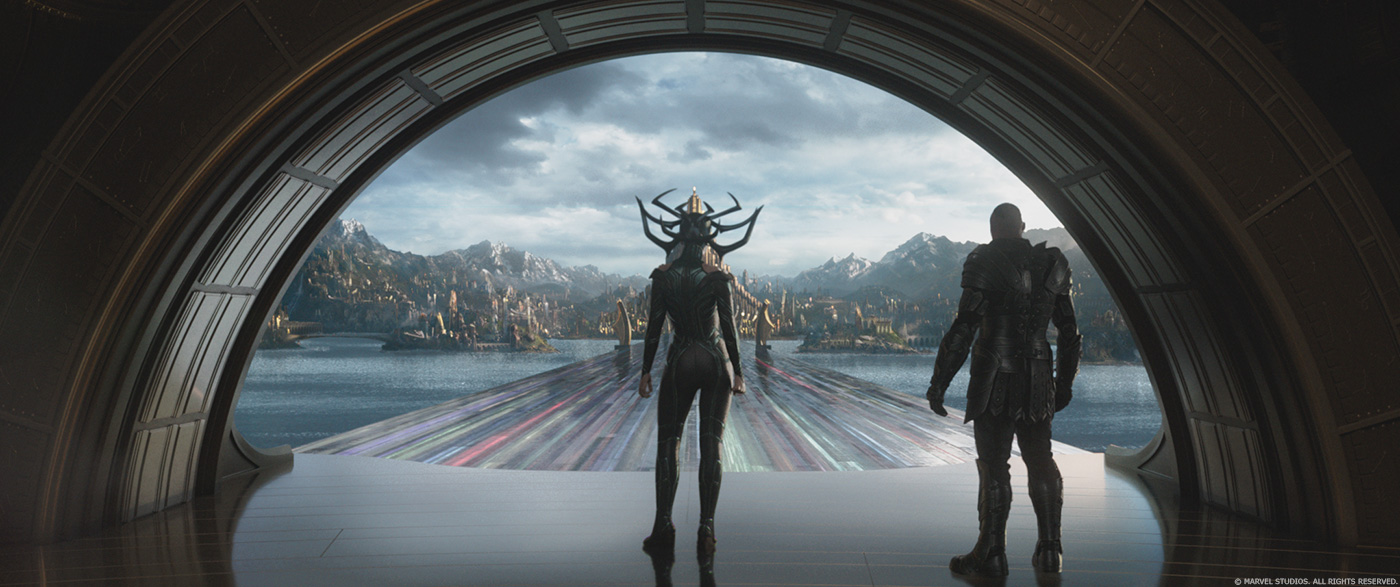
Can you explain in detail about the design and the creation of Surtur?
Surtur is a character from the Marvel comic universe so the starting point was the comics, and Marvel supplied multiple concepts. They narrowed the options down to one particular full frame concept. We then had our concept artists develop different views and details based from that idea. There is a lot of interpretation that needs to take place to go from an illustration to a believable, living/breathing character, particularly with Surtur. There is a lot of movement on his surface and below the skin.
His physical presence was a hot topic for a while. When I first got involved with the film, Surtur was 12 feet tall; the physical set of his throne was built for a 12-foot tall Surtur. Then he was scaled up to 18 feet, which meant we ended up replacing the practical throne with CG. Surtur’s character was to be somewhat broken physically. We withered one of his arms, gave him a heavy limp and made him fairly lean, but when we did that, the fight with Thor looked too unevenly matched, so we beefed him up to Arnold Schwarzenegger type proportions. That looked too big so we toned him back down and didn’t make as much of his arm and leg being deformed.
The component parts we built started with a skeleton, which we would see silhouetted through the magma surface. Then we built a muscle system for him to both hold form through his movement, but also give us both directionality to the flow of molten “lava” and some structure beneath the surface that we could see diffused through a molten skin. On top of that, we added “slag,” a rocky cooled down component that toned down his brightness and gave us some surface detail that we could sculpt some character into. The finishing touches came from having flames and embers licking up his surface.
We rendered out all of the pieces individually and put them back together in comp. Whilst it is a fairly standard way to put a character together, in this case, it also allowed us to have his performance drive the intensity of the effect. The scene starts with Surtur fairly subdued having dialogue with Thor. Here we kept his “temperature” low, into the deeper reds and oranges, with minimal fire and embers. Then as the scene progresses, he literally fires up like a fiery mood ring.

How did you manage his facial animation?
For the face, we needed to develop a way for the slag to move without stretching and squashing. We used Houdini to create a cracked skin broken up enough to allow facial movement. It looked like a face cracked up into 1,000 pieces and allowed the face to move, but the individual pieces did not bend or stretch, only the cracks in between opened and closed. Like his body, we used muscles system to give proper movement to the skin and to provide some structure to see beneath the surface.
Initially, Director Taika Waititi did the voice for Surtur, but that changed late in August and Clancy Brown provided the final VO. We received footage of Clancy delivering his dialogue, which was helpful, but the plan was always to hand animate Surtur for both his face and full body.
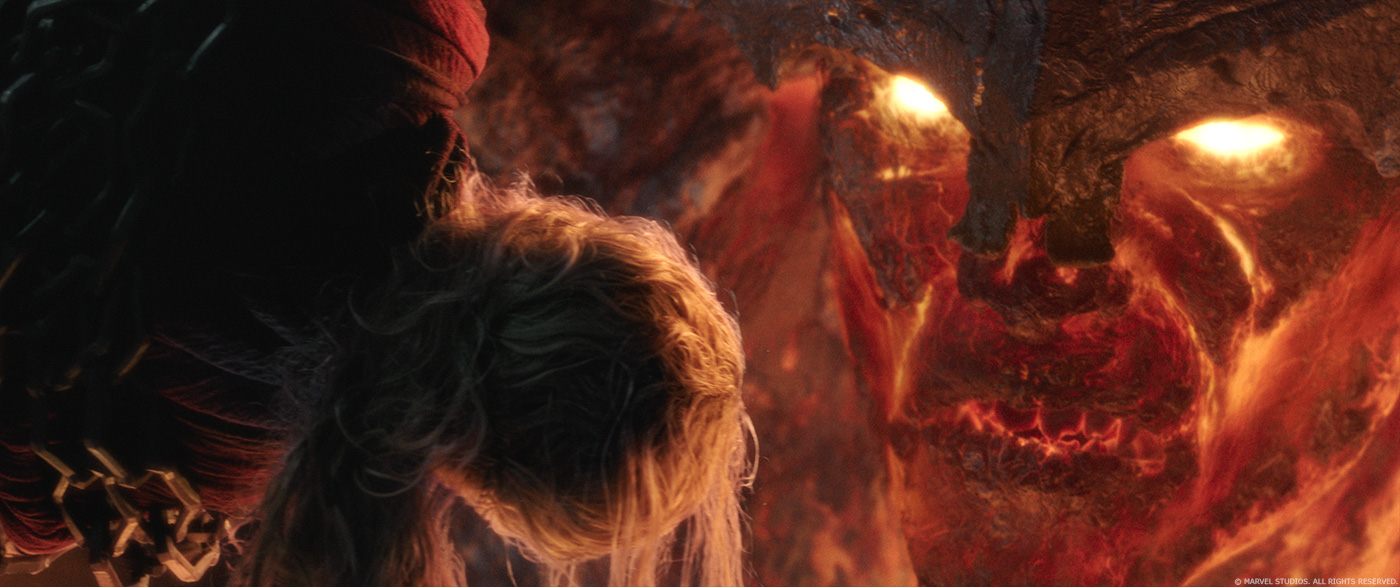
How was simulate his presence on-set and for the interactions?
Given Surtur’s molten, fiery, self-illuminated quality, Chris Hemsworth as Thor was always shot with an interactive “Surtur light,” to help the two work together. Chris was often rigged on a wire to enable him to leap at Surtur. There was a practical rig of Surtur on set to make sure Chris leapt and hit Surtur at the desired spot. The stand in for Surtur looked like a giant character made of pipe cleaners. It was never intended to represent Surtur in a shot, just give interactive light and provide a guide for position when Thor interacted with him. We obviously removed the rig and replaced it with our CG Surtur.
How did you create the digital double of Thor for his fight against Surtur?
The Thor digidouble was provided to us via ILM, who built it from scans production provided. They supplied us with the model and textures, then we rigged him, added hair and a cape, built shaders, etc.
How did you approach the choreography of this fight and create it?
It started as previz prior to the shoot, and continued on as post-viz. This was handled by production. There were a number of shots that were handed over to us early so we could develop all of the assets needed. The scene was continually developed until re-shoots in July/August. This gave us a pretty solid base to go from.
The sequence takes place in a massive cavern. How did you create this huge environment?
Production built a small portion of the set, which was scanned: the throne, a 10m x 10m area of floor and a couple of partial columns. This gave us a great starting point as to what the surface was made of, generally obsidian mixed with stalactites and rock. Because the throne was not built at the right scale and the framing of shots changed considerably, we ultimately replaced 95% of the practical set, only using some small areas of floor directly under Thor’s feet to keep the interaction between him and the floor. It was built and textured in Maya, displaced in Houdini and rendered in V-Ray. Again the starting point was concept provided by Marvel that illustrated the area beyond what was built practically, though in the case of Surtur’s lair and the surface of Muspelhielm, we did expand a lot from the original concepts. I remember Production VFX Supervisor Jake Morrison mentioning to me early on that we should approach the sets a bit like theater sets and “put everything on wheels.” This thinking allowed us to nudge pieces around for better framing in any given shot. We built five large columns for close-ups then another 12 dozen for wider shots and a lava-fall behind the throne. We also added lots of cracks in the floors with lava flowing in them and scattered rocks, from boulders to small pebbles. We could move any component part around to help frame any given shot. Then in the far distance, we had matte paintings provide extensions to the caves to enlarge them. We always knew we would have to have thousands of fire demons crawling along the roof and columns, so we built most of the set out in 3D to allow for that.
An army comes to help Surtur. How did you create the various soldiers?
The fire demons were modeled and textured in Maya, displaced in Houdini, then rendered in V-Ray. The concept we were provided for the fire demons (we called Surtur’s army fire demons) was solid and we didn’t deviate much. We built five variations with a rig that allowed us to mix and match with the horns to give us more variations.
How did you manage the crowd creation and animation?
We used Golaem to create the crowds and Marvel provided us with tons of mocap data of stunt people doing all manner of running, jumping and crawling. Our animators also provided run cycles and many specific actions like them crawling down columns. Anything close to camera or interacting with Thor was animated.
Lots of FX and destructions happens during the sequence. How did you created these elements?
All the FX work was created in Houdini. We had cracks in the floor with rivers of lava running along them and lots of embers. Whenever Thor hit a fire demon with his hammer, we had them shatter into pieces, and created spark elements for the impact and large showers of embers and the odd fireball.
Given Mjolnir gets destroyed in the film, Taika wanted it to have a moment in the opening scene alongside Thor at full power. There is a profile shot tracking with Mjolnir smashing through endless fire demons, an above shot doing the same and then a shot with Mjolnir flying at the audience then Thor calls for it and it turns and flies back to him, all the while smashing through endless fire demons. We wanted to do a fire demon support group shot for the end credits where all the fire demons sit in a circle and discuss the trauma Thor puts them through, but unfortunately we didn’t have time to do this.
A dragon comes into the fight. Can you explain in details about his design and creation?
Marvel provided us with a solid starting point with a 3D model, which gave us the basic proportions and some details like the whiskers. Unlike most dragons, she doesn’t have wings, and is instead propelled by rocket type thrusters emitting from gills down her rib cage. Other details changed quite a bit along the way. She started out coming from the same type of finish as the fire demons and Surtur, with a rough burnt charcoal type outer surface and a hot molten surface underneath, with lots of fire down the spine and along parts of her body. These ideas worked well with the rough burnt charcoal look, however, she was looking a little too complicated and we weren’t getting a good read of her form, so we tried a more leathery finish. This helped get a better read of details like muscles under the surface and generally made her less complicated.
What is your favorite shot or sequence?
Probably the Eguard (Elite Guard) fight with Hela, although I’m very proud of the teams efforts in Surtur’s lair. The Eguard fight was a unique challenge due to when it was delivered. Up until mid-August, the fighting part of the scene happened in a single shot. We’d been working on the shot for around two months, so it was pretty well developed and used a full digital version of Hela, no live action. Then we had a call with Marvel and it was decided to cut the scene up and use live action Hela. The scene was extremely challenging in its complexity.
We had half of the shots acted out with a stunt double of Hela so we could match move her actions but couldn’t use her face. Then we had many live action Eguard without their helmets and wearing padded suits so we had to remove and then match move them. On top of all of this, there were around 400 crowd Eguard that were always moving in on her, and we needed to thin them out fairly quickly. Add to that around 10 skiffs that needed destroying, and we did it in seven weeks. We tracked cameras, matchmoved all of the relevant Eguards and Hela, and cleaned up all of the plates before we could start animating. This alone took between two and three weeks, which left four weeks for animation, lighting, cleanup, sorting out intersections, adding capes, blowing up skiffs, throwing a multitude of weapons and have Hela believably kill 400 Eguard.
What was the main challenge on this show and how did you achieve it?
VFX is a team sport, and to achieve what we did in those final weeks – the revised Hela Eguard battle, redoing all of the dialogue for Surtur and reworking the entire scene with new takes of Thor and creating the scene of Skurge and Hela with the Asgard citizens and Fenris – was only possible because of a massive team effort. The project may have been challenging, but it was quite special to be a part of.
How long have you worked on this show?
13 months.
What’s the VFX shots count?
We finalized 481 shots that went into the film, and many more that were cut.
What was the size of your team?
We had a total of 294 artists working on the project at Method, with our peak week having 190 direct contributors on the team.
What is your next project?
I can’t say due to non-disclosure agreements.
What are the four movies that gave you the passion for cinema?
BLADE RUNNER, APOCALYPSE NOW, TAXI DRIVER, and JAWS.
I was born in the early 60s; these were the films in the cinema during my impressionable years!
A big thanks for your time.
// WANT TO KNOW MORE?
Method Studios: Dedicated page about THOR: RAGNAROK on Method Studios website.
© Vincent Frei – The Art of VFX – 2017



